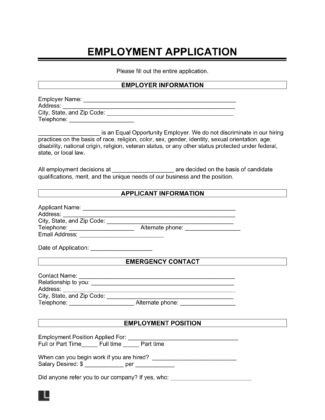
Use our job application form to collect information from potential job candidates.

Updated February 29, 2024
Written by Sara Hostelley | Reviewed by Brooke Davis
A job application lets you efficiently search for suitable candidates to interview and hire at your place of business. You can distribute a blank form to each prospective employee, allowing each candidate to provide their personal information to help you decide who to hire.
This document places potential employees on an even playing field. Each completed form features the requested information in the same place, allowing you, as the hiring manager or human resources (HR) employee, to wade through applications quickly and efficiently, especially when looking for specific skills or education that can enhance your business.
A prospective candidate can visit the physical address of your place of business and fill out a paper job application you provide. They are less common than online applications but may still be used by some employers, particularly for in-person job fairs or as an alternative for individuals without internet access.
Online job applications are submitted electronically through the company’s website or job search platforms. It is often allowed for the submission of resumes, cover letters, and other supporting documents in various file formats.
Depending on the platform, candidates may be able to create an account within a few seconds, allowing them to easily create a connection to your company.
Email job applications involve sending application materials (resume, cover letter, etc.) directly to the employer’s designated email address.
Here are some sections to include in an employment application:
The employer fills out this section with the company’s name and the hiring manager’s contact information. They can also include a statement about being an Equal Opportunity Employer to encourage more applicants.
The employer can fill out this section in advance and print out several dozen or hundreds of copies, depending on their hiring needs. Then, they can distribute the applications to potential candidates so the candidates already have the employer information.
Within this section, the applicant starts providing their information. They provide their legal name, residential address, and contact information. They can also specify the date they’re applying.
An applicant can also add their emergency contact information so the employer knows who to contact in case the applicant experiences a medical or workplace emergency.
Here, the applicant can specify the position to which they’re applying. They can also state their preferred employment type and salary. As an employer, you can filter out candidates by focusing on ones who respond according to the company’s needs.
This section addresses whether a potential employee is legally eligible to work in the United States. It also addresses whether an applicant can work overtime and night shifts and has reliable transportation to work.
Ensure that you only request this information for practical purposes. Don’t design your questions in a way that elicits discriminatory information. For example, refrain from asking questions that have a candidate reveal their age, race, sexual orientation, citizenship, disability status, or criminal history.
This section includes spaces for applicants to list high school, university, or college degrees, training in other educational facilities, or specific online courses they’ve completed.
Ask for an applicant’s job history in this section. For each prior position, request the name of their previous employer, their job title, and the responsibilities and duties they had. You can also see how long they held specific positions, which can help you assess their likelihood to remain in one position for the long term.
Have them list their current employment status. If they currently have a job, request the start date and their current duties.
Let them tell you about any military service they’ve completed, including the branch, the years they served, and any specialized skills or training they acquired.
Leave blank spaces for applicants to list hard and soft skills. They can self-assign the proficiency they have in each skill, whether it be Low, Medium, or High.
Allow applicants to list personal and professional references which attest to their character and work ethic. Create spaces for them to put their references’ contact information and their relationship to the reference.
Depending on the type of job the candidate seeks, the employer may request a more in-depth reference letter.
Include a statement that certifies all the information is accurate to the applicant’s knowledge. Create a spot for the applicant to date and sign their name, allowing you to interpret the application as a valid submission of precise information.